Ever felt like hopping in the car and roadtripping in one of the least densely populated countries on earth? We did exactly that: wild camping anywhere we wanted to pitch our tent in the remote emptiness, and driving 3700 kilometres, give or take (about a 1/4 of those off-road – you can drive almost anywhere you want, too). The endless steppe, the Gobi desert, mountains, and an icy lake on the southern border of Siberia …just bring an extra sleeping bags. Herds of camels, herds of horses, and herds of yaks, roaming free or sometimes corralled by cowboys on motorcycles. Ancient canyons once full of dinosaur bones, old monasteries in otherwise desolate valleys, dusty little towns where time seems to stand completely still. And only had one minor breakdown in all of that…
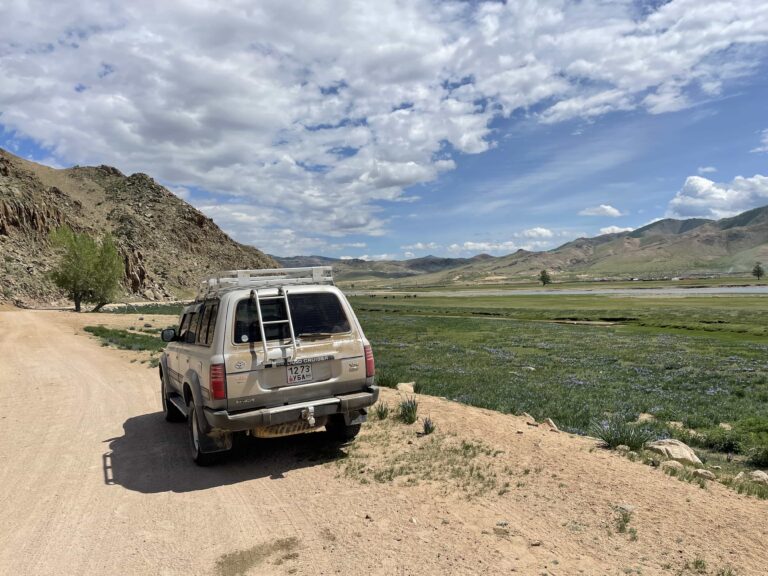
Self-driving in Mongolia is definitely one of the world’s ultimate roadtrips. Thinking about taking it on? In this post I’ve outlined our 16 day self-driving itinerary, and I’ve provided information to help you plan your own ultimate roadtrip:
Transportation
Self-driving
Before you go – planning your trip
On the road – our itinerary
Back to Ulaanbaatar
If you like roadtrips then this one’s got it all. In case you’re wondering what you’ll find along the way, I’ve written a story about the very best of what we saw and did. Check it out here: Roadtripping in Mongolia: an off-road adventure.
Transportation
This post is about self-driving, but there are a few different ways you can travel around in Mongolia. Starting from Ulaanbaatar (UB), the capital, you can plan to travel by:
- Car and driver. The most popular way to go. You can join an organised tour, or you can hire your own private car with a driver (so, essentially also a tour). You can do this alone or you can band together with other travellers you meet in Ulaanbaatar. You are along for the ride and don’t need to worry about anything, although with a private tour you can of course plan your route and stops. This alternative is cheaper than hiring your own vehicle and driving yourself. To us, it looked boring – you just get kind of carted around from place to place. However, it’s definitely easier and you aren’t on the hook for the car, don’t have to worry about breakdowns or getting lost in the Gobi desert, or any of that type of thing.
- Public transport. The cheapest way to go is public transport but overall it’s not a great alternative in Mongolia. This will take a lot of time, where you can actually go is pretty limited, and you can’t just stop whenever you want to take photos, hike, and so on. There are bus connections between the bigger towns. However, there are not many big towns and when you get to them there is not that much to see or do in or close to the town itself. Most likely you’ll have to hire a car and driver to do anything outside town once you get there.
- Self-driving. You can drive your own car or rent one without a driver. Self-driving costs a lot more than public transport and actually even more than hiring a car with a driver. It’s surprisingly expensive to hire your own vehicle in Mongolia. For us it was more than worth it to pay (a fair bit) in exchange for total independence, and to be fully in charge of our own plans and pace. I’d say this is by far the best option, as long as you feel comfortable with the drive itself and with being alone in isolated areas.
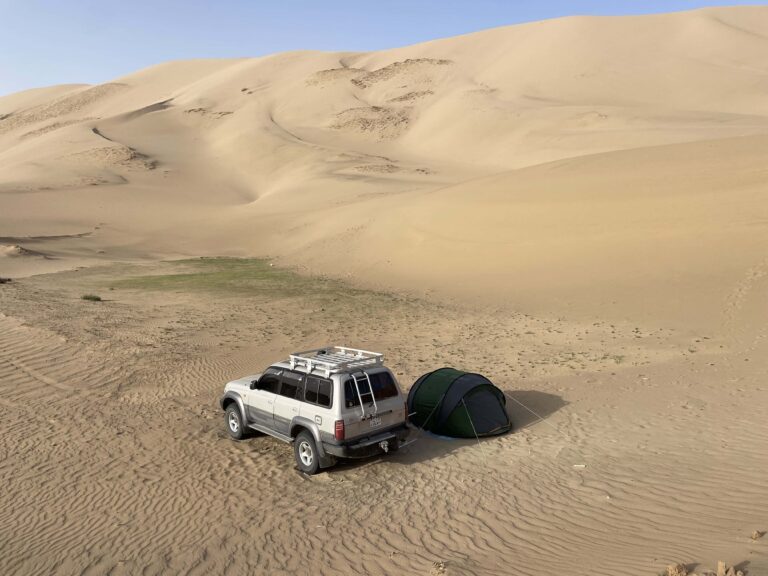
Self-driving
We are in no way strangers to long, agonizing trips on unreliable and sometimes downright dangerous public transport. In fact we relish it and very often set off to do exactly that. We’ve taken on large swaths of Africa by public transport and that is no small feat. But in this case we decided to hire our own car and self-drive in Mongolia, wild camping on the way. That brought with it some different considerations, which I cover in this post.
If you decide to hire a car and self-drive in Mongolia, here are some things you’ll need to think about:
- Finding a car. There are a few travel companies who hire cars with camping equipment available. We contacted about four. One never responded at all, and one had sky-high quotes. Two were very prompt, responsive, and very helpful: Drive Mongolia and Mongolia.Travel. We met with both of these in person and got a lot of valuable insight from both, they took time to answer a lot of questions and help us figure out what would work best for us. They are both better and cheaper than for example, Sixt and Hertz, who never answered our emails. Sixt, which we visited in person, didn’t even send us the quote as promised after the in-person visit.
- It’s not cheap. Just because an astonishing number of locals drive a Prius come hell or high water, doesn’t mean you should undertake to do the same. You need a 4WD, and you can expect to pay around 120-250 USD/day (plus fuel) for a decent vehicle in low season. Most likely you’d be looking at minimum 200 USD per day in high season, depending on the car. We were quoted 120 USD for a small Suzuki Jimney or similar, and 250 USD for a modified Toyota Land Cruiser. We ended up renting an unmodified Toyota Land Cruiser for 160 USD/day (original offer 180, we bargained and low season was on our side). It was perfect for us as we needed space to carry the gear and food for camping every night. Both the companies I mention above include unlimited kilometers, and throw the camp gear in on top as well.
- Accommodation. Do you want to bring a tent and camp, or stay in ger (yurt) camps? That will have some bearing on the vehicle you choose (i.e. if you need space to carry camping equipment, food, a fridge, and so on). It will also affect your costs – you can camp pretty much anywhere for free, staying in gers will obviously cost you. Some ger camps are actually just local people’s extra ger on their farm and that would be a cheaper and more authentic experience. If you haven’t already stayed in a million yurts in Kyrgyzstan, you could go for that. Many ger camps are built-up tourist developments and for the most part didn’t look appealing to us. We camped in our own tent, on purpose to get away from it all. In Mongolia you can camp anywhere as long as it is not private land or right next to a place of worship.
- Insurance. It’s not going to work the same way as it does in Europe (or wherever): for example, there’s no third-party insurance. So don’t hit anyone. Also the standard insurance the company offers might only cover up to half the value of the car. Depending on what sort of damage you potentially inflict, you could be on the hook for all of it, or for the total value of the car, so check what your own travel insurance covers. You can’t buy any regular insurance with a standard deductible from the rental company (unless you rent from Sixt or Hertz most likely). The entire rental process is very casual – we never once signed anything, there’s no real contract – you just take the keys and go.
- Mileage. We had unlimited kilometers and you definitely need that. On our 16-day road-trip we drove around 3700 kilometers.
- Your rental company. In the low season we barely saw other drivers while off-roading. In case of a breakdown you might have to wait several hours to a whole day for assistance. The rental companies know people in most towns who they will send to help – assuming you have signal on your phone and can call them. Your car provider should have a contingency plan and be reachable. When you’re arranging the car hire, ask them how they handle breakdowns and repairs. They’ll probably want to know at least an outline of your plans in advance and talking it over is a good idea – they can advise you about your route, and they’ll know approximately where you are. Ours asked us to check in daily on WhatsApp (if we had signal/wanted to). And, when we did in fact have a minor problem with the engine, they were extremely prompt in getting us in touch with a mechanic and fixing it fast (no cost to us, either).
- Collecting the car. You’ll pay the total up front and fork over a deposit in cash, usually around 500 USD. Make sure the registration papers are in the car. We got pulled over by the police a few times but they mainly just waved us through rather than ask for the papers. Any police we met were really nice, couldn’t speak English anyway, and absolutely never gave us a hard time for any reason.
- Fuel. Top up the tank whenever fuel is available. Stay as close to full as possible. Fuel is also more expensive the further you go so definitely fuel up in larger towns when you can. In larger towns we could pay for fuel (and food) with card.
- Road conditions and traffic. The roads vary constantly from smooth pavement, to sealed roads with potholes, to gravel roads with volcanic rock, to flat sandy roads in the steppe, to straight-up sand, and so on, but are often a lot better than you think. Traffic isn’t really an issue outside UB: in the low season (early-mid May), we could off-road drive for most of the day without seeing another vehicle.
- Driving. Last but certainly not least, consider your driving skills. We ended up driving off-road for around twenty-seven percent of our trip. We didn’t encounter difficult driving conditions other than sometimes a bit of sand or shallow water. However, later in the season some of the rivers will be deeper so you should cross only where other cars have crossed, and check the depth before crossing. A good rule of thumb for driving in Mongolia: if in doubt, just wait for a local to show up, inevitably driving a Prius in the most insane conditions, and show you how it’s done.And, one more thing to keep in mind: they drive on the right side of the road in Mongolia but in around eighty percent of cars, including our Land Cruiser, the wheel is also on the right side.
Before you go – planning your trip
With a little advance research and emailing, we managed to pick up a car on the spot when we arrived in UB overland from China. We wild camped every night (but one, in Kharkhorin) so we obviously had no bookings whatsoever. Many (but not all) ger camps were open when we were there at the end of low season, and if we’d wanted to stay at one we could have just walked in. That was in early-mid May.
However, if you are planning to go between June to September, you should book your car as early as in March. Cars get booked out in high season, and so do ger camps. If you’re planning on mainly staying in gers during the high season, you should check availability and book ahead.
When to go
Mongolia has a short tourist season (June to August/September), when thousands of South Koreans descend on the country because a Korean influencer recently Instagrammed a lot about it. Judging from the number of deserted yurt camps and karaoke bars it really does kick off, but in mid-May we were thankfully ahead of the crowds. We usually had the road and stops along the way entirely to ourselves.
Weather is also a factor, of course. We were there in late spring and without any other seasons to compare to, I would still say that that was the best time for us. It was a little chilly sometimes especially in the higher altitudes, but for the most part we had sun – and no crowds.
Starting from September/October, it just gets colder and colder, and of course snow in winter will make the driving a lot more difficult and camping impossible, in lots of places.
How many days
Before you book your car you should sort out your itinerary so you can figure out how many days you need. We ended up doing a 16-day loop of the central southern and northern regions of Mongolia, approximately 3700 km. It was a good mix of the Gobi desert, Buddhist monasteries, and the more rugged north.
If you want a shorter trip, you can plan for the Gobi desert and monasteries only and return to UB on our day 9.
Or, you could drive north to Lake Khuvsgul and make a circuit to Kharkhorin and back to UB.
You could also drop the national parks on our first and last days (Terelj and Hustai, respectively) to shorten your trip by 2 days. Both of these are fine to visit if you’ve got the time but if you don’t, you aren’t missing anything really special.
Basically – how many days do you want? For us, 16 days was a very comfortable amount of time to do what we wanted without rushing at all.
Things to bring
- Cash. Pull out tugrik (local currency) from ATMs in UB before you leave. It turned out we could pay by card at petrol stations in bigger towns, and at Nomin hypermarkets. Small places, entrance fees, gers – you’ll need cash for those. Basically, just bring cash to cover everything, and do not rely on card.
- Maps.me is indispensable. We would not have been able to do this trip without it. It has great off-roading track details and doesn’t run on your data. In addition to the actual route and off-road tracks, a lot of detours, stops, and ger camps are marked on it. Google maps will not cut it, other than on sealed roads.
- Google Translate and the Mongolian dictionary for offline use. This came in very handy for us, especially when we needed a mechanic. And certain foods. And almost anything.
- Powerbanks. You’ll probably be able to charge via a usb in the car (check on that. We needed to buy an adaptor to do this), and at night if you stay in a ger, but a powerbank or two is a good idea.
- Flashlight. For night time bathroom trips, if nothing else. Which reminds me: toilet paper.
- Food and water. We always made sure we had enough drinking water and cooking/washing water. We did most of our grocery shopping at Emart in UB on our way out of town. If you want cheese make sure you pick it up in UB. Your food choice, especially fresh food, gets really limited once you leave UB. You can pick up more supplies at Nomin hypermarkets on the way in the ‘bigger’ towns and some very basic items in the mini-markets which abound in every little village. We cooked almost all our meals in our camp sites and that was not only really nice, but also convenient. Make sure you bring gas bottles for your stove – you can find these in most mini-markets along the way.
- Camping gear. If you plan to camp, you can bring your own or most rental companies will throw it in for you. We had a tent, mattress, sleeping bags, table and chairs, stove, basic crockery set, and a fridge, included in our rental. Bonus if you can get an awning.
- Warm clothes in layers. You may need to sleep in them. In the summer, even. We had extra sleeping bags as well and we needed them at the lake. I slept with my toque on.
- Toolkit. This, and two spare tires, should obviously come with your car.
- And, super important to us at least: we are coffee lovers and always travel with an Aeropress to easily brew good coffee on the road.
Costs
Your budget should include the car, fuel, accommodation if you’re going for gers, and food on the road. For us it worked out like this:
- Toyota Land Cruiser with camping gear. 160 USD/day.
- Fuel. We spent a total of about 455 USD on fuel, including a final top-up before returning the car.
- Food. We spent about 350 USD on food, basic supplies, gas for the cookstove, wine, and beer. Of note here, food’s pretty cheap but we don’t like to cut corners there so we bought all kinds of nice stuff (from what was available anyway) and cooked 3 good meals a day.
- Entrance fees, road tolls, incidentals. You don’t encounter a lot of entrance fees and when you do, they are small – say from 1 to 3 USD per person for a monastery or similar. Hustai Park is the only ‘expensive’ one here, at around 10 USD per person. Road tolls are negligible – less than 1 USD here and there. Incidentals are up to you – for us, this was mainly coffee at any decent cafe we came across.
- Accommodation. We spent 35 USD on one night’s accommodation (Gaya’s Guesthouse). Otherwise, we camped. Apparently ger camps will range from 10 – 30+ USD per person, depending on standard etc. We brought enough cash to cover a few nights in gers but never bothered as we were perfectly happy camping.
In total about 3600 USD on the road, for two people on a 16 day trip. Of this, the car we paid up front and the rest we paid on the way mainly in cash (local currency of course).
Keeping in touch
- WiFi. Some cafes had WiFi. I assume some ger camps would too.
- SIMs. We bought 2 local SIMs, Unitel and Mobicom. This meant we had coverage most of the way apart from really remote areas. In our experience Mobicom worked the most often. Bringing two different ones is a really good idea.
On the road – our itinerary
This post is about our experience self-driving in Mongolia and wild camping for 16 days. You can certainly adapt any part of our itinerary to suit yourself with a car and driver. Some parts can also be done by public transport.
To find out more about these places we stopped and camped at, you can read this post about the very best of what we saw and did along the way.
DAY 1 – Ulaanbaatar to Gorhki Terelj
Kilometers: 108 | Hours: 2.5
Gorhki Terelj National Park is only 70 km from Ulaanbaatar. People go there as a day-trip or short overnighter from UB, or, you can build it into your road-trip as we did.
On the way out of UB we stopped at Emart Chinngis to stock up on most of our groceries for the entire trip. Ulaanbaatar traffic is pretty insane so set off after 09:00 and before 17:00. When driving out of UB make sure you detour 19 km to see the massive statue of Mongolia’s main man, Genghis Khan.

As it’s so close to UB, Terelj is very developed and even over-crowded with ger camps. Since we were there on a weekday in low season, it wasn’t an issue for us (if you overlook the post-apocalyptic atmosphere brought on by so many desolate ger camps). There’s a famous rock formation if you’re into that kind of thing, and the Buddhist Temple up in the beautiful hillside. We camped just down from the monastery and it was very peaceful.
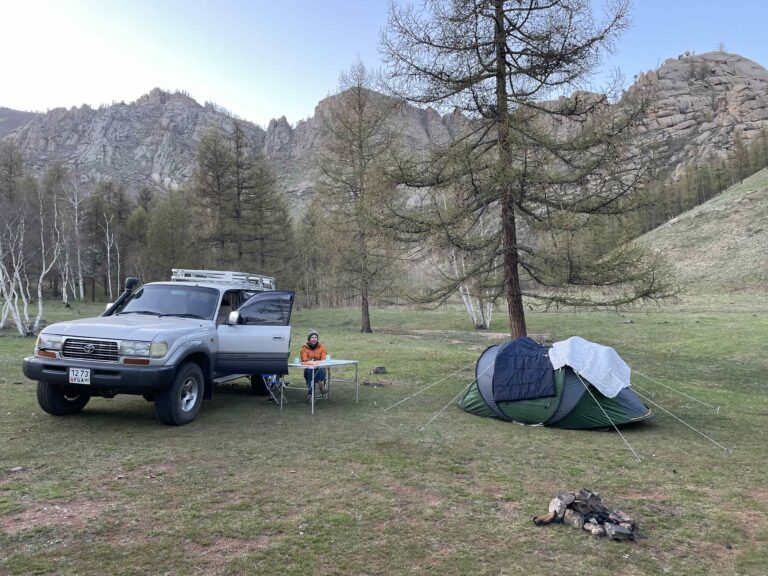
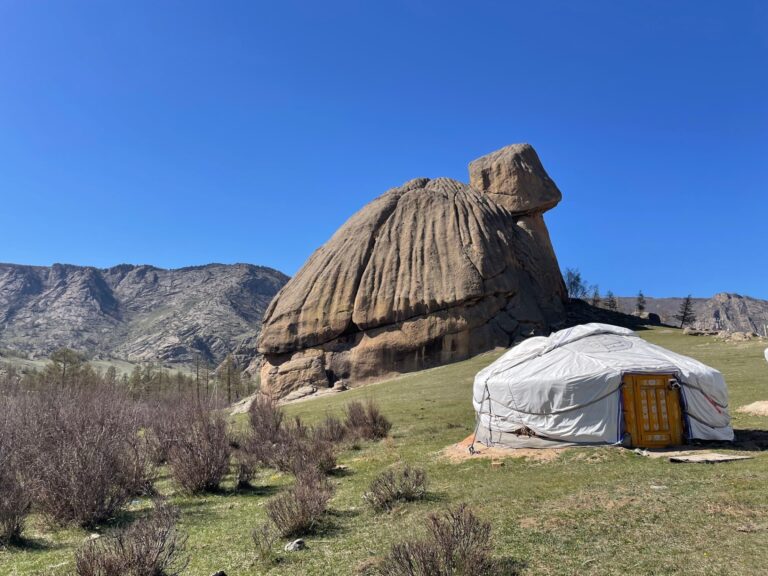
DAY 2 – Gorkhi Terelj to White Stupa (Tsagaan Suvarga)
Kilometers: 510 | Hours: 8.5
This day is a long driving day, so get an early start. The road is sealed all the way until the last 37 km, with lots of potholes most of the way until Mandelgovi. We fueled up there and you can also grab supplies at the Nomin hypermarket.
Following Maps.me we attempted to off-road from a shortcut marked ‘good dirt road suitable to 2WD sedan’. This got us lost until we changed Maps.me from driving to hiking. The best way would be to just follow the main route on Maps.me and not attempt random shortcuts. Plot in Tsagaan Suvarga.
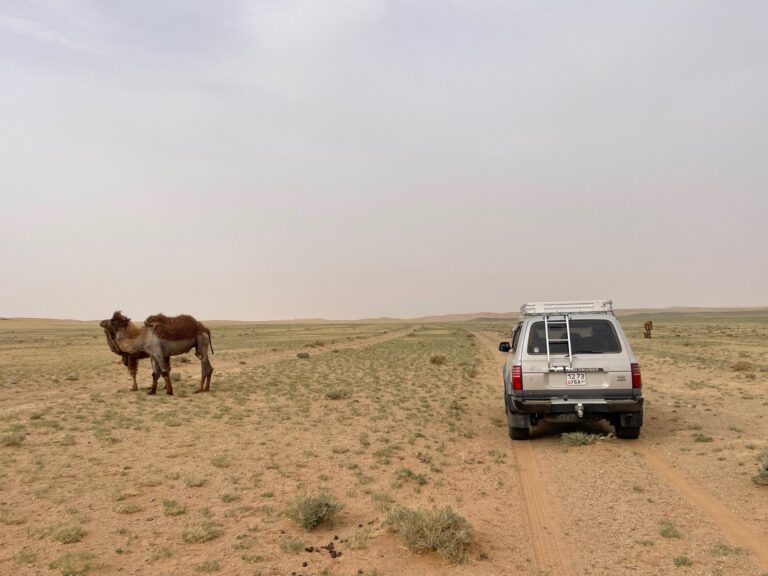
The drive goes through beautiful trails on the steppe, then turns into light sand and gravel closer to the stupa. There’s an area at the top of the White Stupa where you can park and pay a small fee. We didn’t do that but instead just drove around to the foot of the stupa following the tracks on the right side. These tracks are a little steep at times so take it slow. At the bottom there’s plenty of space to camp with great views of the stupa. From there you can hike up to the top in 10-15 minutes.
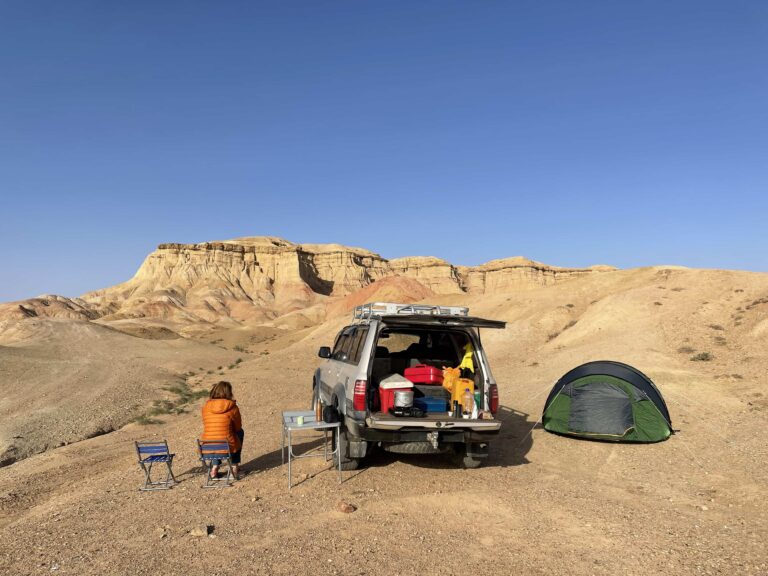
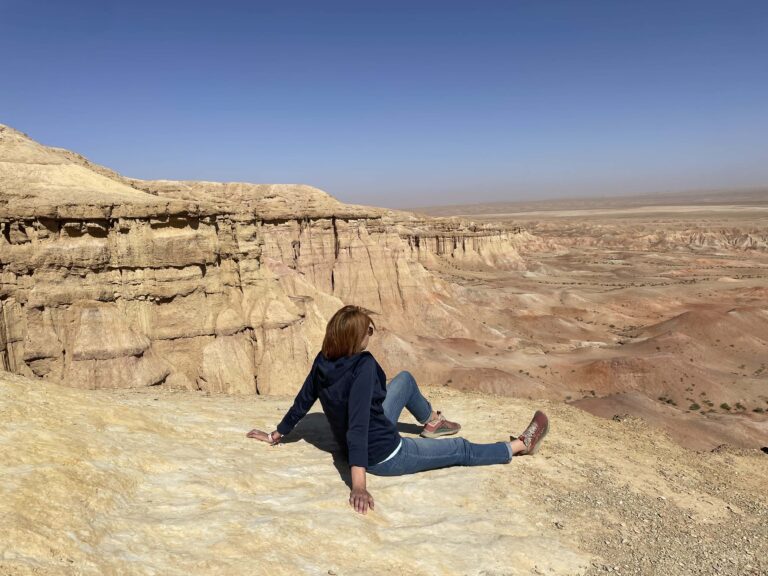
DAY 3 – White Stupa to Yol Valley
Kilometers: 210 | Hours: 3
If you didn’t drive in on the ‘2WD sedan ‘shortcut”, you’ll be driving out the same way you came in, 37 km to the paved road. The road is in good condition with sand and gravel, then you reach the sealed road going towards Dalanzadgad. The first thing that meets you after the elaborate town gate is a massive Nomin hypermarket. So, no worries about supplies. And you can get a pretty decent cup of coffee at Caffe Grande.
From Dalanzagad it’s another half hour till you get to the entrance of the National Park that Yol Valley is inside of. In mid-May there was nobody there to collect the park fee of 3000 tugrik. After the gate it’s another half hour/10 km to the parking lot, which is the starting point for the Yol Valley walking trail. In mid-May the trail lies under a thick icefield that still hadn’t melted. The trail doesn’t really have an end – just walk as far as you feel like and then turn back.
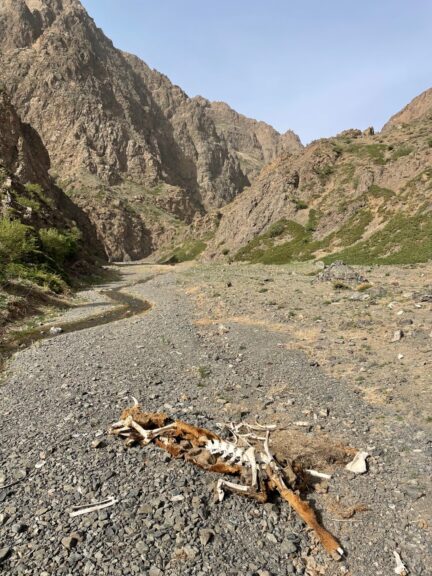
Don’t camp around the parking lot. We drove back about 2 km and found a beautiful little valley close to the road on the right hand side and set up our camp there.
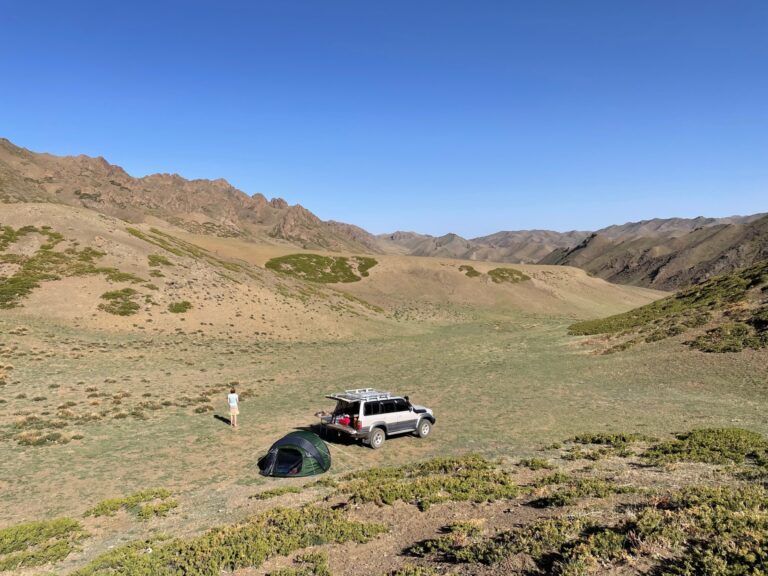
DAY 4 – Yol Valley to Khongoryn Els
Kilometers: 180 | Hours: 4.5
The road to Bayandalai is in great condition. In town you can fuel up (the next gas station is in Bulgan), get supplies, and a decent cup of coffee at Tod coffee shop. After Bayandalai the off-roading starts on a light sandy steppe road in good condition. After some time it turns into gravel and eventually to light sandy tracks. This whole day is pretty much off-road, and we rarely saw another vehicle.
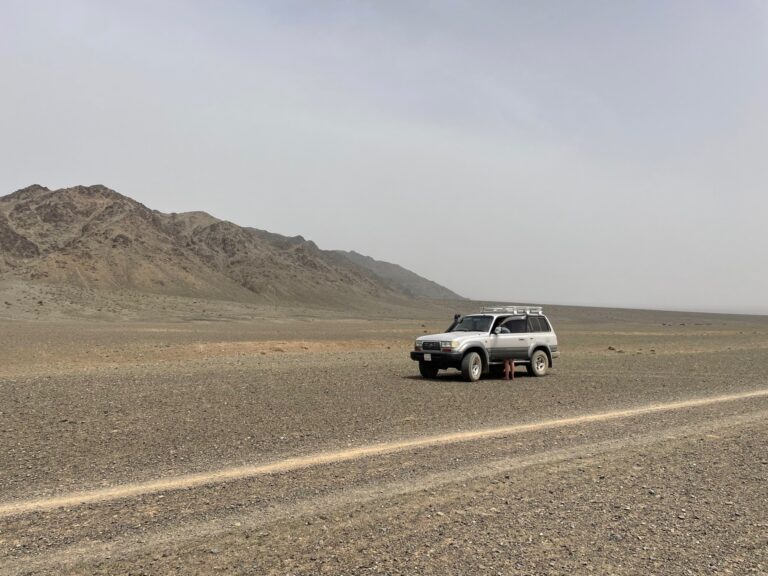
We arrived at Khongoryn Els is a sandstorm, but found our way with Maps.me. You pass through an entrance gate close to the sand dunes – some of the tracks on Maps.me go through a fence which looked pretty new. From the gate you drive another 10-15 minutes to the biggest dunes. You can camp anywhere close to the dunes. There are plenty of gers outside of the gates scattered around here and there but nothing close by to disturb you.
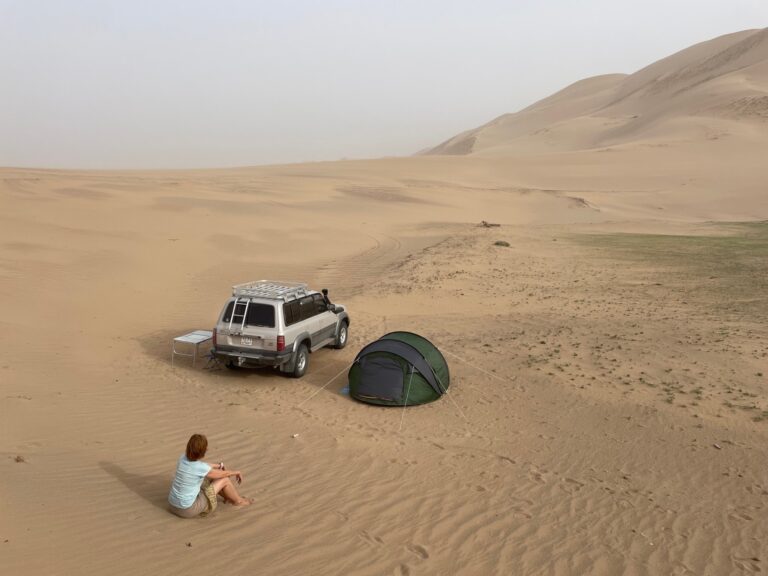
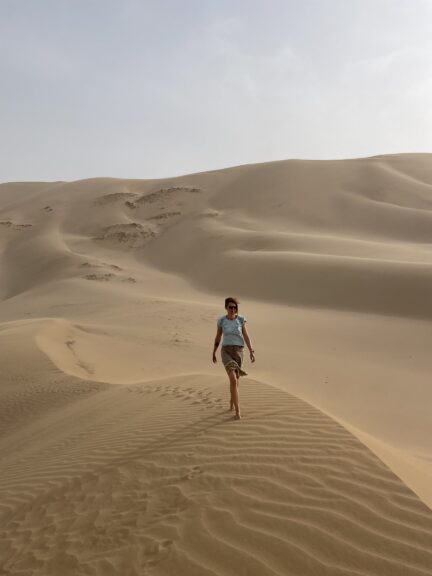
DAY 5 – Khongoryn Els (rest day)
The weather changed for the better and we stayed an extra day at Khongoryn Els. This was a good way to break up some of the driving days. We climbed up the dunes at sunset and sunrise. It’s about a 45 minute climb if you’re in reasonable shape and it’s actually pretty tiring but also pretty awesome, don’t miss it. These are some of the biggest, cleanest, emptiest sand dunes I’ve seen.
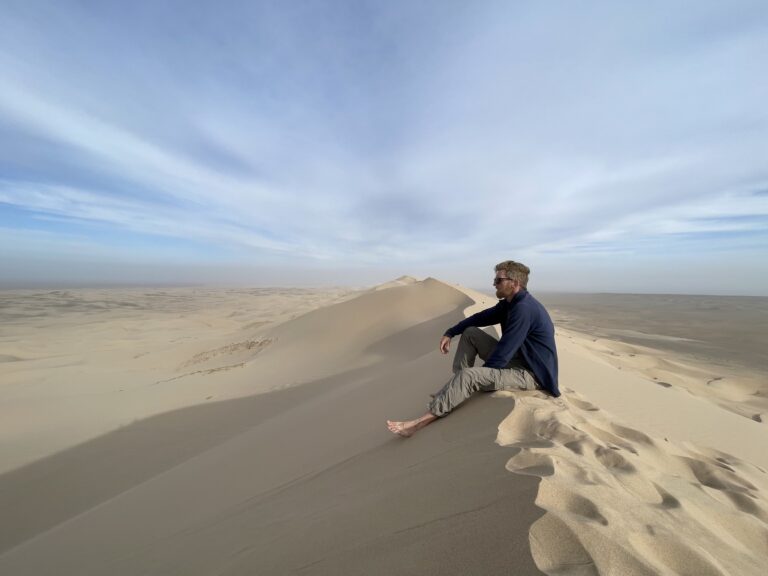
DAY 6 – Khongoryn Els to Flaming Cliffs
Kilometers: 150 | Hours: 3.5
The drive to Bulgan takes around three hours on good, sandy off-road tracks. In Bulgan you can get supplies, fuel, and coffee. After Bulgan it’s only another 30 minutes to Flaming Cliffs. The area is fenced off and you have to pass through a gate and pay a fee. We camped in a sheltered spot next to the cliffs. Again, just drive around until you find a spot that suits you, and set up.
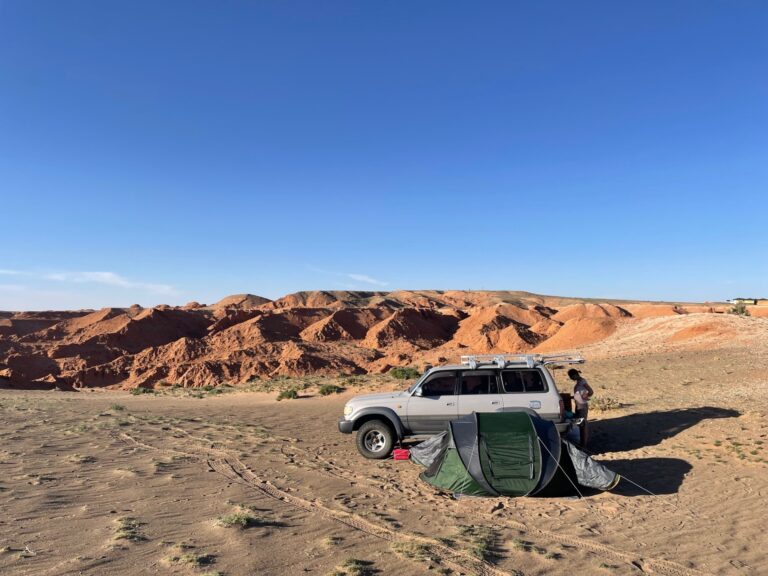
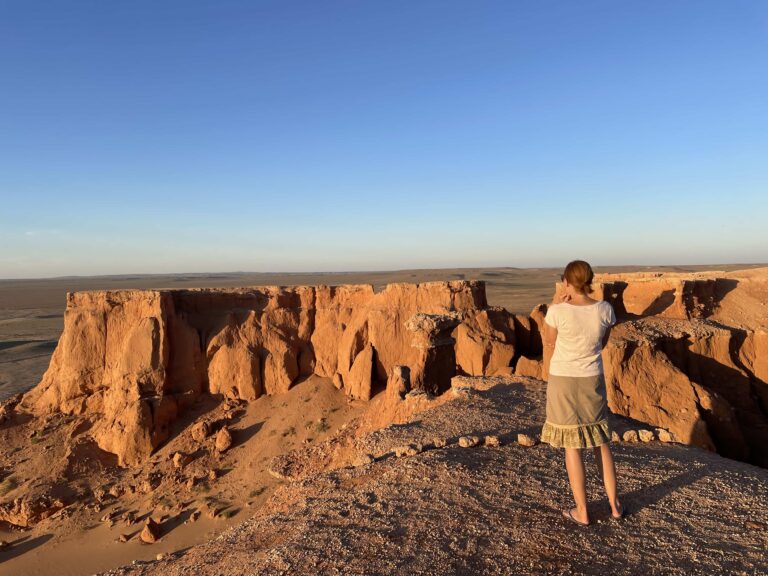
DAY 7 – Flaming Cliffs to Onjiin Monastery
Kilometers: 190 | Hours: 3.5
The landscape to Mandel-ovoo is interesting and we were really on our own driving through the desert. Again, this entire day is off-road, and we barely saw another vehicle. Once you reach Mandel-ovoo you can stock up on supplies and fuel (but no coffee). After Mandel-ovoo the road turns into steppe and you can go pretty fast on smooth tracks – be careful. Around here, we got a flat tire and our engine started making an ominous hissing noise. We changed the tire ourselves, and in the next town got a mechanic to take a look at, and fix, whatever was going on with the engine.
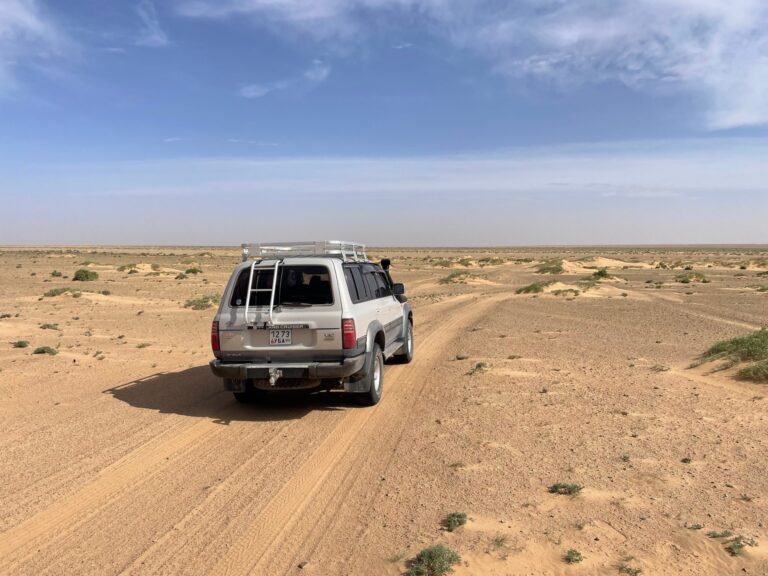
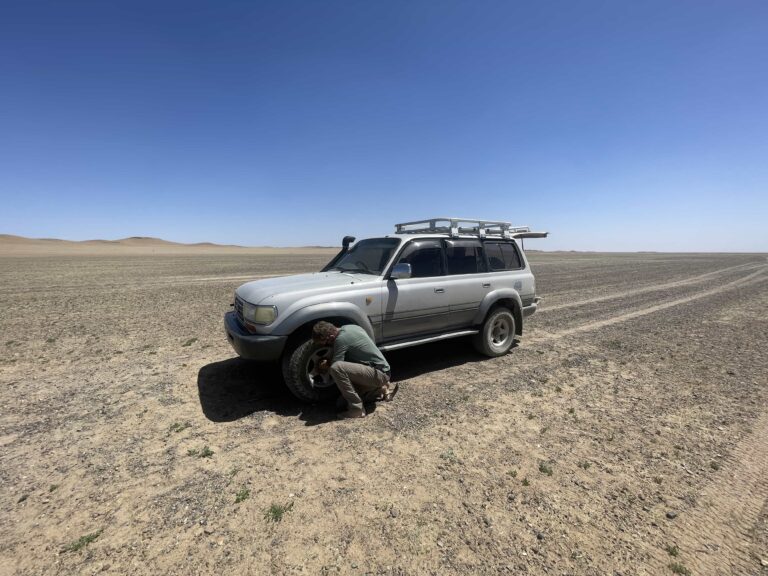
In Ongiin we camped by the river close to a ger camp called ‘Secret of Ongiin’. It’s actually a pretty spot and you can visit the old monastery ruins from here, and drop by the camp’s restaurant if you want.
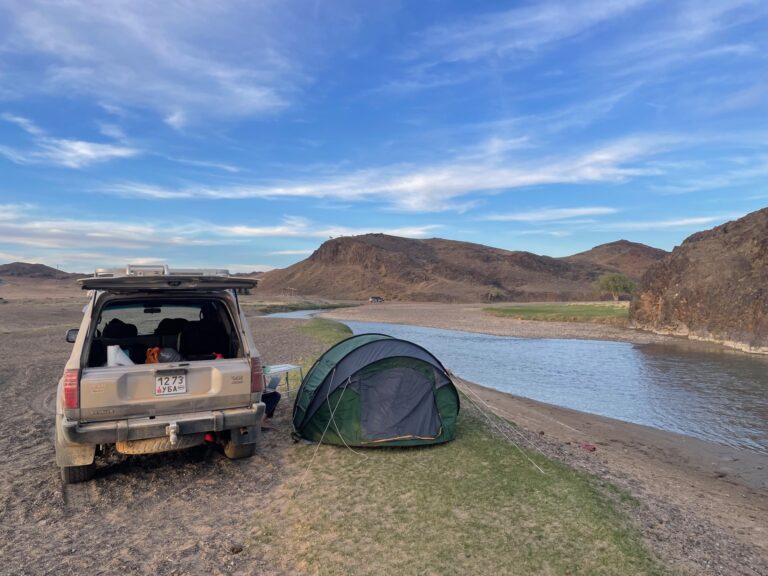
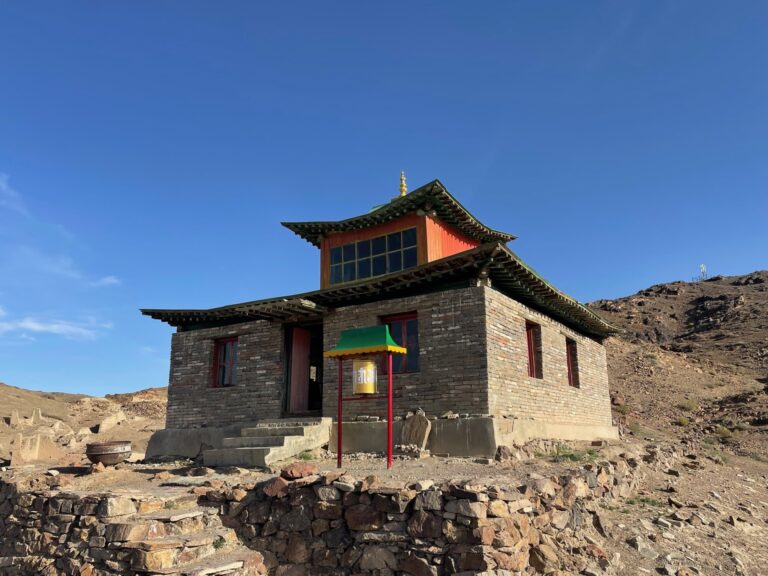
DAY 8 – Ongiin Monastery to Kharkhorin
Kilometers: 330 | Hours: 5
The drive to Saikan-ovoo, where you can fuel up (and see a mechanic), takes around half an hour. After Saikan-ovoo it’s another 2 hours off-road on sandy tracks in good condition, till you reach the paved road. From the paved road it’s smooth sailing all the way to Kharkhorin.
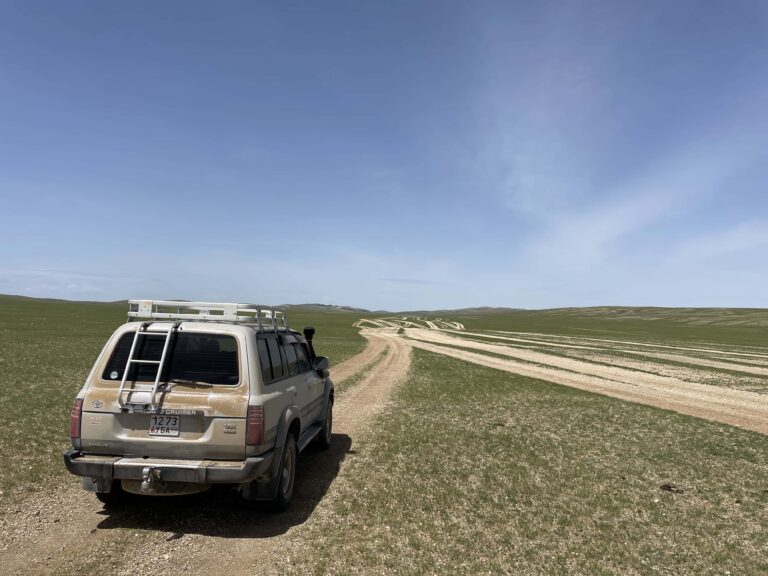
In Kharkhorin we checked in to Gaya’s Guesthouse for a proper shower and beds, for the first time in a week (and only time altogether, for that matter). We also went out for dinner here (you are not missing anything if you don’t). From Kharkhorin if you’re making a shorter trip, you can drive straight back to UB the next day.
DAY 9 – Kharkhorin to Khorgo-Uul Volcano
Kilometers: 285 | Hours: 4
We went to Kharkhorin Monastery in the morning. Give yourself a little time to explore there.
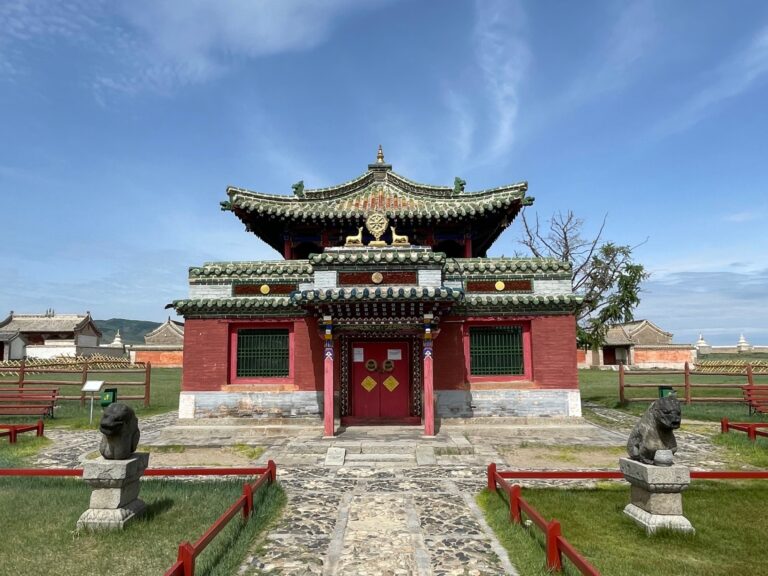
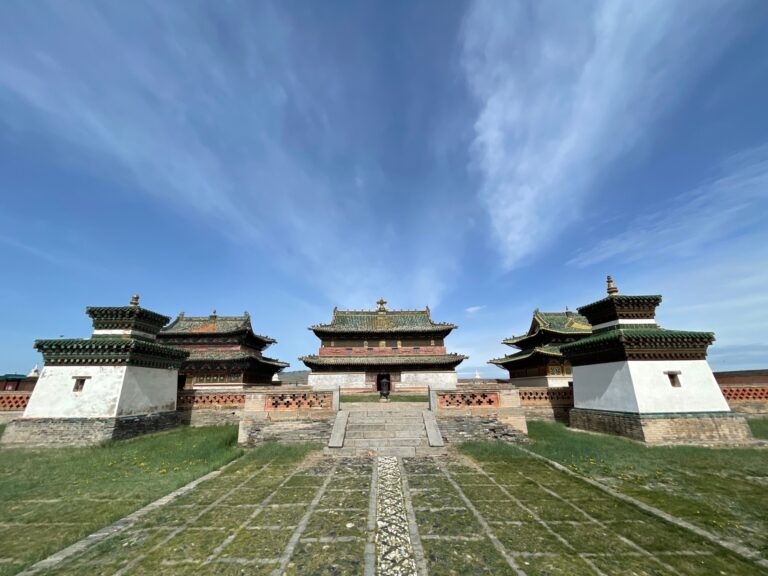
The road to Khorgo-Uul is mostly paved, with a few short stretches of hard gravel over some small hills. We stopped in Tsetserleg on the way to eat at Fairfield cafe, which is probably the only place outside of UB worth eating an actual meal at. The town itself is another unappealing Mongolian town, there are quite a few of those.
After Tariat the road turns into volcanic gravel for the last 5 km until you reach the base of the volcano itself. It’s bumpy going. We drove past the gers into the valley and found a sheltered place to camp.
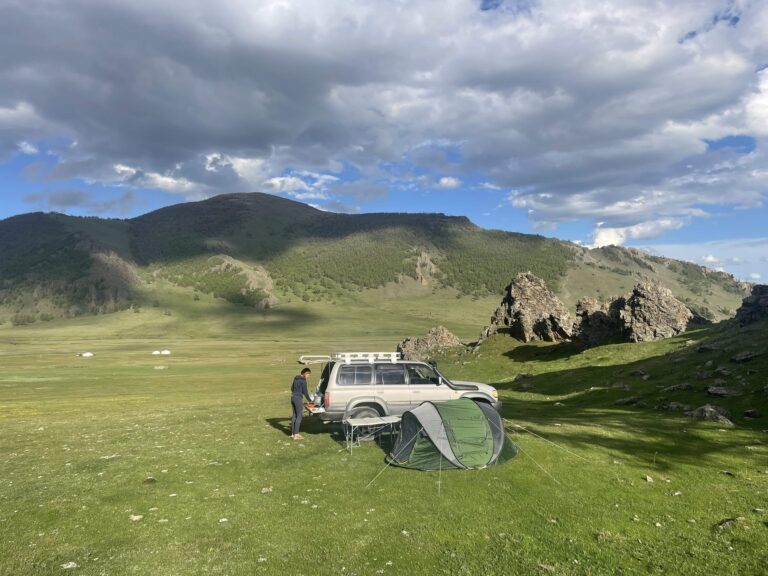
The volcano itself is not wildly impressive (climb up and take a look) but we liked camping there as the surrounding nature is beautiful.
DAY 10 – Khorgo-Uul Volcano to Murun (Moron)
Kilometers: 310 | Hours: 9
This is a long driving day so get an early start. The first 140 km are nicely paved. After that it’s off-roading all the way to Murun. Maps.me will for some reason try to get you to go around through Ikh-Uul over the bridge and back to the other side. We did that, but for once Maps.me let us down. Instead, you should drive towards Jargalant and go over the bridge just before the village. This should save you an hour.

After Jargalant the road is ok but it gets more remote. There is a small mountain pass before you get to Shine-Ider. After Shine-Ider it gets very remote again and you go through another small mountain pass before you reach Lake Zurkh.
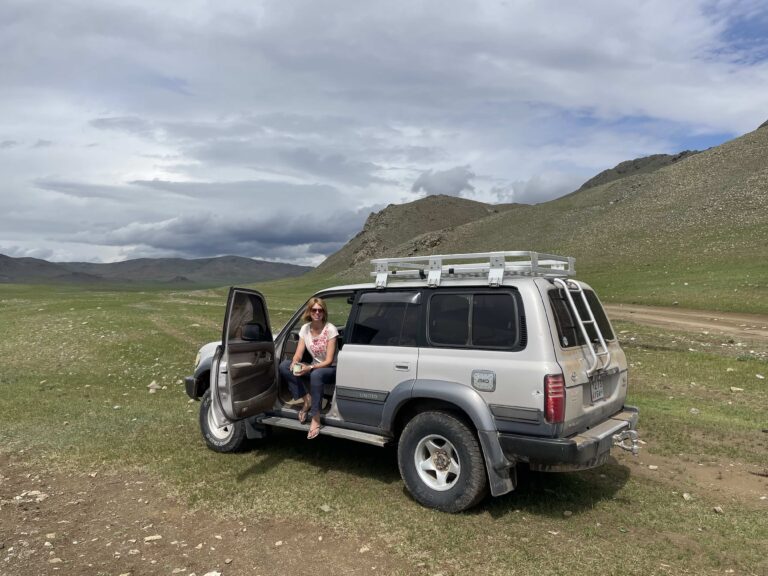
Be careful around here, and in general in more remote areas: sometimes there are a lot of tracks criss-crossing each other wildly and your map will be confused. In cases like this you actually want to stay ‘on the beaten path’ as that is your best bet for actually getting somewhere at the end of the day. The tracks will merge again and match up with your map…eventually.
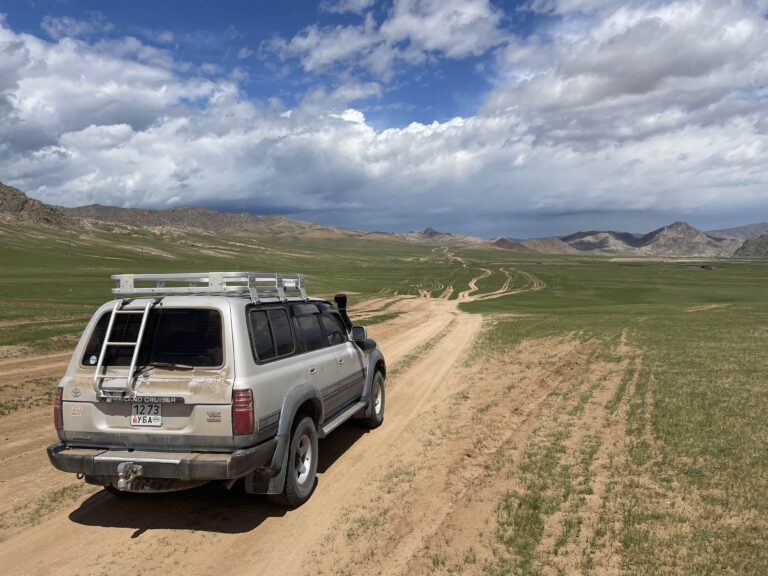
We took the wrong track for a while, and although it looked pretty dubious we kept going, until the car teetered on the edge of a huge rut in the road at the bottom of a hill. On the verge of getting stuck, Oyv nevertheless felt the best plan of action was to attack the road with a shovel and dig a new level track himself, rather than backtrack and find the right one. Then a nomad showed up on a motorcycle out of nowhere and made a gesture at us which was either asking us to join him for a drink, or else accusing us of already being drunk (probably that, based on our apparent road-construction plans). He waved his arms dramatically and had us follow him around and back onto the proper track. So, you don’t always need Maps.me.
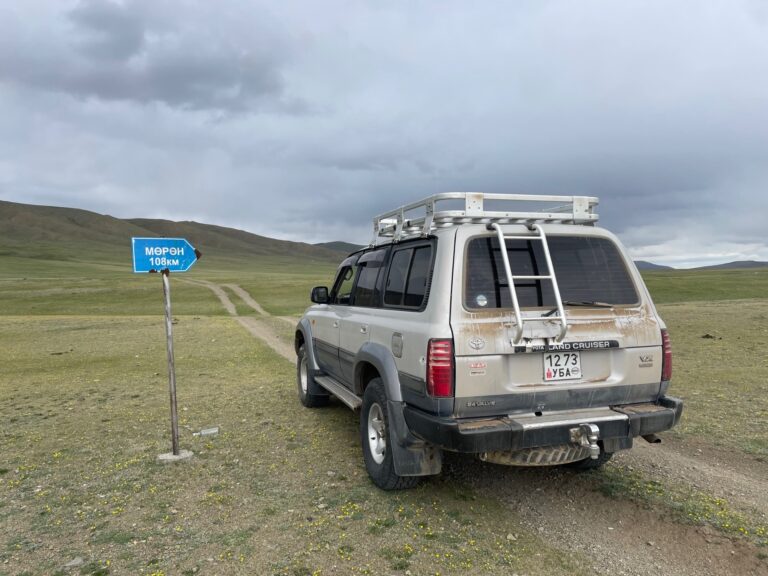
Just before you reach Murun you get to a river. We camped there as if you drive any further you’ll reach town and be camping in a field on the outskirts.
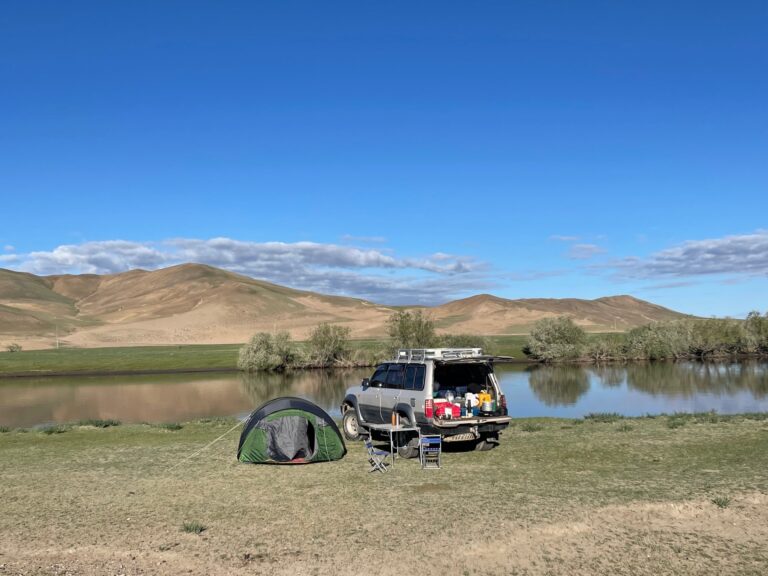
DAY 11 – Murun (Moron) to Lake Khuvsgul
Kilometers: 100 | Hours: 1.5
Murun is the second biggest town in Mongolia. Here you can stock up on supplies at the ubiquitous Nomin hypermarket and top up your fuel. Arya is a nice cafe with good cake too.
From here the road is sealed all the way to Hatgal and then you can drive up either side of the lake on hard gravel. In mid-May the lake was still frozen further north so we camped close to Hatgal on the eastern side. The western side seems to have more gers.
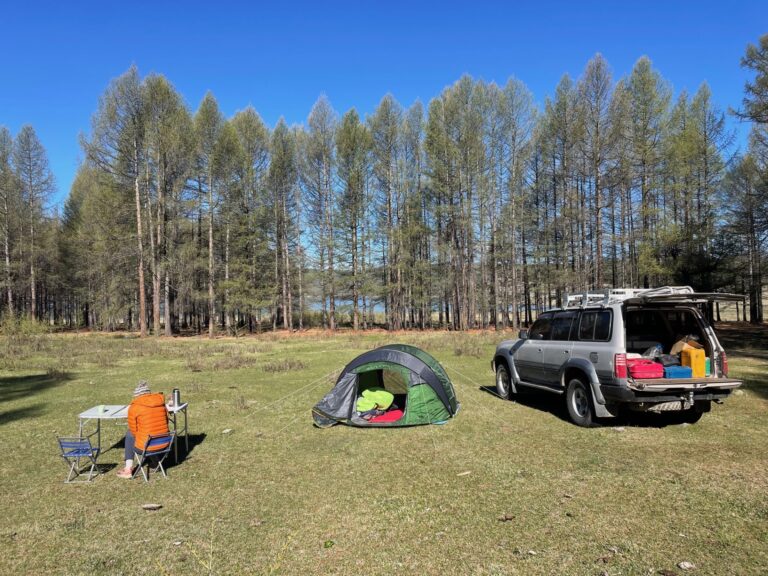
DAY 12 – Lake Khuvsgul (restday)
This day we just spent relaxing at the lake. A lot of the space is closed off private property so there’s only so much we could do. Apparently during the season you can kayak and so on, but we were early, so we just drove and walked around the edge of the lake and hung out in our campsite.
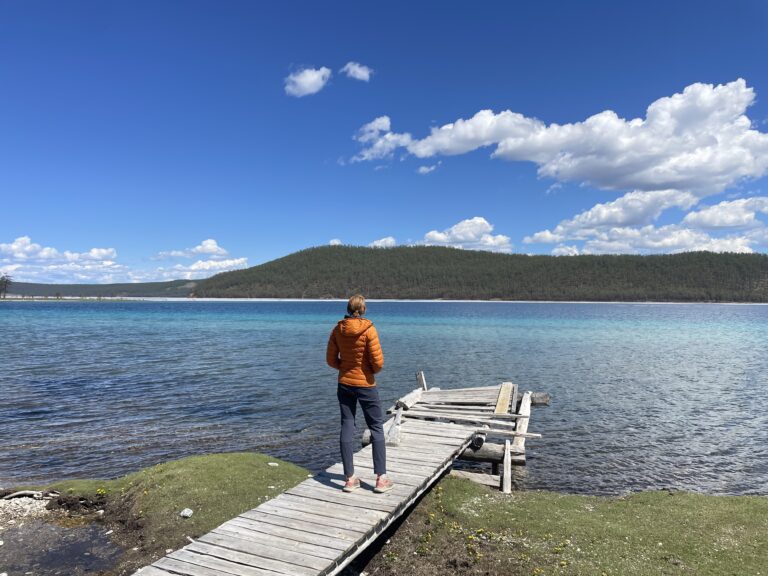
DAY 13 – Lake Khuvsgul to Uran-Togoo vulcano
Kilometers: 370 | Hours: 5.5
This is a driving day, which we used to basically break up the otherwise very long journey from the lake, to Amarbayasgalant monastery. We drove on a sealed road for most of the day, and then another 10 kilometers off-road to where we randomly stopped to camp.
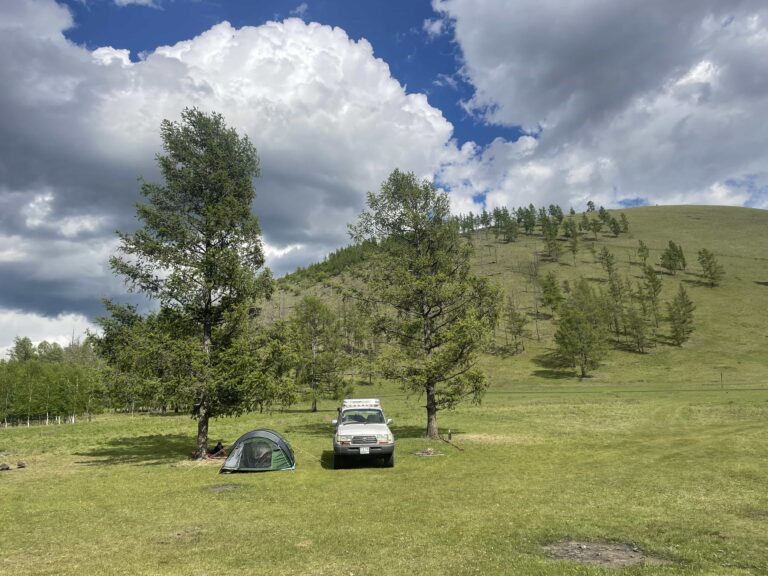
DAY 14 – Uran-Togoo vulcano to Amarbayasgalant Khiid
Kilometers: 250 | Hours: 4.5
We drove from our campsite back out to the main road. From there we continued towards Amarbayasgalant monastery on a sealed road all the way until you reach the turn-off and go off-road for the last 35 km. Before the turn-off, we stopped in Erdenet for coffee and some supplies.
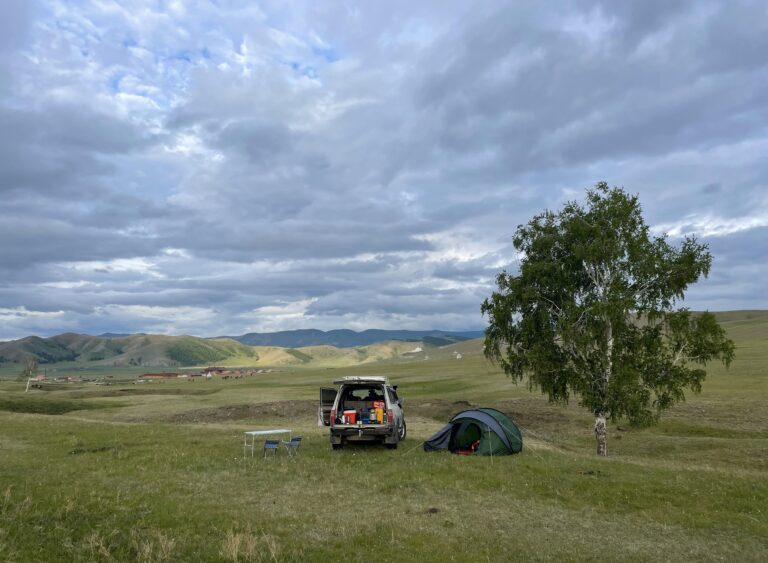
You can camp anywhere you like in front of or around the monastery. Make sure you give yourself time either this afternoon or the next morning, to explore the monastery complex and walk up to the stupas behind it as well.
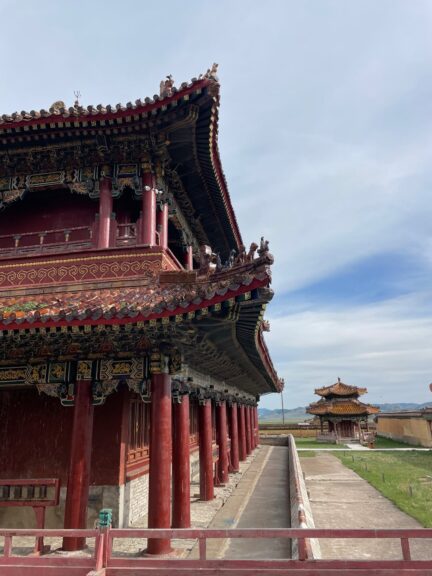
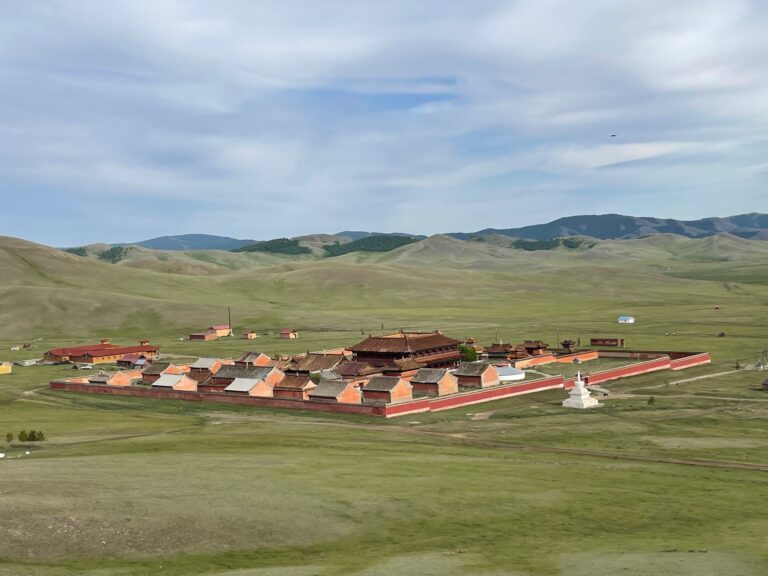
DAY 15 – Amarbayasgalant Khiid to Hustai National Park
Kilometers: 392 | Hours: 6
Drive the same 35 km off-road from the monastery back out to the sealed road. Then, it’s sealed road all the way until the turn-off for Hustai National Park. From there you drive about another 13 km to the park entrance. There’s a big car park area where you pay the 35 000 tugrik per person entry fee. The big draw for this park is the wild horses which you may (or may not) see as you drive through. There’s absolutely no camping in the park itself anymore and most people stay in the big ger camp next to the park entrance. There’s also a basketball court there and some empty space where you can apparently pitch your tent, and use the showers and other facilities in the ger camp.
That did not seem appealing to us so we drove back the same way we came towards the main road. On the way there are some rolling sand dunes and camped in those instead. Again, if you wanted to you could just drive straight back to UB skipping the park.
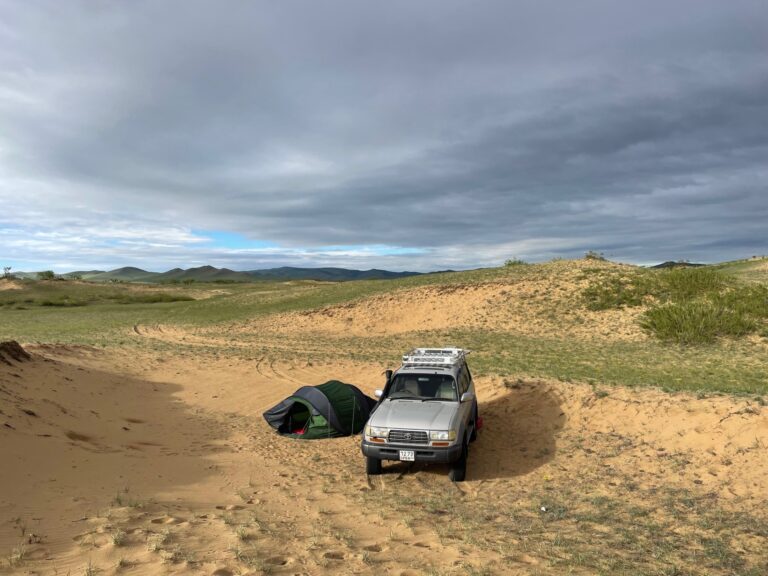
DAY 16 – Hustai National Park/campsite to Ulaanbaatar
Kilometers: 95 | Hours: 2-3 (traffic can be wild)
Like the heading says: after breakfast we dismantled our last campsite and drove back to UB. Beds in a guesthouse (City Guesthouse and Tours, very nice), hot showers, a couple of cold beers:)
Back to Ulaanbaatar
After all that sandy dusty off-roading and driving in the empty windswept steppe, heading back into Ulaanbaatar was by far the worst part, driving-wise, of the whole trip (tied with driving out of it, 16 days earlier). UB is a little chaotic and messy, especially if you arrive at rush hour after a road-trip where passing two other cars in the course of a morning was a noteworthy occurrence.
‘I want the spaghetti carbonara’ I’d said one night as I attempted to make dinner on the camp stove in a small windstorm, without stirring in more than a couple mouthfuls of sand. I was referring to an Italian place in UB that’s definitely one of the better options in town. So after we’d settled into our guesthouse and gotten presentable (more or less) we went straight there. It was a sunny afternoon in UB and we were feeling pretty great. The trip was fantastic and we lingered over our pasta and wine with a sense of accomplishment, thinking over everything we’d just seen and done.
Read More
To read more about travelling in Mongolia, you might want to take a look at this post:
Roadtripping in Mongolia: an off-road adventure
Or, if you’re still in China but thinking about heading to Mongolia by land, check out this post about crossing the border from China to Mongolia.




This Post Has 11 Comments
Thank you for writing this trip report. Super helpful!
You’re welcome, glad it’s helpful:)
Hi, thank you for your trip report. How much cash do you think we have to have during 16 day trip for 2 people? And yes, we like to have a glass of wine and beer😉
Hi! We spent around 800 USD in food and fuel (and glasses of wine and beer 🙂 ). We had that amount with us in cash (local currency), plus enough for the small costs on the way that I outlined in the Costs section above. We also brought extra cash ‘in case’ we stayed at gers – and then we did not. So in the end, we had a lot left over. We noticed that in any big town where we restocked (at say, a Nomin hypermart) we could use card, some gas stations too. Basically, consider if you’re going to camp, or stay in gers – they’ll want cash. I’d say bring a little more than you think you need (better safe than sorry).
Hi, What rental company did you go with? Sent two emails(Drive Mongolia and Mongolia Travels) and didn’t get an answer…Do they use Whatsapp?
Hi! we went with Mongolia.Travel (I think the ‘dot’ part is key there). Anyway we had fast email response from both, it might be time of year in your case – I’d try again. We did have WhatsApp contact with them both too. Send me an email from the blog Contact page, and if I can find the WhatsApp numbers I’ll pass them along:)
Hi , can´t find Mongolia.travel, could you pass me number or website. Thanks for the uselfull content shared in your post
You’re welcome:) Sent you the phone number.
Camping is great but could you share what you did for your toilet needs. Of course the pristine remote landscape allows a lot of privacy but Ould like to know does one get toilet tents & portable pottys on rent ? Please do share
Hey, good question lol. I sort of doubt you could hire anything like that – the camping equipment we got was pretty basic. Maybe if you were hiring a car from Avis or another big one? However, there are (also usually very basic) facilities here and there, in or near national parks/sights and so on, if you can wait for those:)
welcome to Mongolia